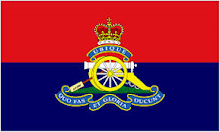 |
| Bucquoy Road Cemetery |
The Bucquoy Road Cemetery is located 9 kilometres west of Arras near the village of Fichieux.
Bucquoy Road Cemetery, Ficheux | CWGC
During World War One the village lay within the German lines from 1914 until March 1917 when the German Army withdrew to the Hindenberg Line. Fichieux then lay 5km behind the front line under British control.
In April 1917 the British First and Third Armies launched an offensive in the Arras Sector. The VII Corps Main Dressing Station was estabished with the cemetery nearby. The 20th and 43rd Casualty Clearing Stations at Boisleux-au-Mont used the cemetery until March 1918. It was not used again until September and October when the 22nd, 30th and 33rd Casualty Clearing Stations were located at Boisleux-au-Mont. When the Armistice was signed the cemetery contained 1,166 burials and later expanded as graves from the surrounding battlefields and small cemeteries were concentrated at Bucquoy Road.
The cemetery contains 1,901 casualties from World War One, of which 1,733 are identified
 |
| Bucquoy Road Cemetery WW1 |
The Bucquoy Road Cemetery is the resting place of two Northumbrian Gunner Officers, 2nd Lieutenants A.R. Rouse and A.J. Sloan who served with 315 Brigade RFA The 315th originated as the 2nd line Northumbrian Brigade Royal Field Artillery, who died at the end of October 1918.
 |
Bucquoy Road Cemetery WW1
Northumbrian Gunner Officers |
 |
Bucquoy Road Cemetery WW1
Indian Gunner Dalip Singh |
 |
Bucquoy Road Cemetery WW1
Canadian Soldiers |
Amongst the Canadian casualties is the grave of J Standing Buffalo. Private Joseph Standing Buffalo was the grandson of Chief Sitting Bull who defeated General Custer at the Battle of the Little Big Horn. Joe was the son of Grand Chief Julius Standing Buffalo, and Alma, of Fort Qu’Appelle, Saskatchewan.
He died of wounds on 29th September 1918.
 |
Bucquoy Road Cemetery WW1
Canadian Soldier
J Standing Buffalo |
On 20th May 1940 the 70th Brigade fought a vital blocking action against German Panzer forces in the area of Fichieux. The 70th Brigade consisted of the 10th and 11th Battalions Durham Light Infantry and the 1st Battalion Tyneside Scottish (Black Watch).
The Bucquoy Road Cemetery became the resting place for many who were killed diring the Action at Fichieux. A plot was was added to the existing cemetery which contains 136 burials and commemorations. This includes 26 unidentified casualties and special memorials commemorate 39 soldiers whose graves in the cemetery could not be specifically located.
 |
| Bucquoy Road Cemetery |
 |
Bucquoy Road Cemetery
World War Two Plot |
One of those killed during the action was Lance Corporal Freddie Laidler, a piper who lost his life playing his pipes to encourage the Tyneside Jocks fighting. As the battle raged, Piper Freddie Laidler played his pipes to encourage the fighting Tyneside Jocks. The Regimental history records “piper to the last – carried his pipes into action and was killed with them”.
Freddie was the Great Uncle of Dire Straits guitarist Mark Knopfler who wrote a song dedicated to his memory "Piper to the End"
 |
Bucquoy Road Cemetery
L/Cpl Freddie Laidler
Piper to the End |
 |
Bucquoy Road Cemetery
Tyneside Scottish Branch RAA |



.jpg)
.jpg)
.jpg)
.jpg)
.jpg)

.jpg)
.jpg)
.jpg)













_mine,_Beaumont-Hamel%20(1).jpg)











.jpg)

.JPG)
.JPG)





















.JPG)
















